|
Strain Name
|
C57BL/6N-Cd38tm3(CD38)Bcgen/Bcgen
|
Common Name
|
B-hCD38 mice
|
|
Background
|
C57BL/6N
|
Catalog number
|
110046
|
|
Aliases
|
CD38, ADPRC 1, ADPRC1
|
mRNA expression analysis

Strain specific analysis of CD38 gene expression in WT and hCD38 mice by RT-PCR. Mouse Cd38 mRNA was detectable only in splenocytes of wild-type (+/+) mice. Human CD38 mRNA was detectable only in H/H, but not in +/+ mice.

Strain specific analysis of CD38 gene expression in wild-type C57BL/6 mice and B-hCD38 mice by RT-qPCR. The mRNA expression of CD38 in homozygous B-hCD38 mice (H/H) was similar to those in the wild-type C57BL/6 mice (+/+), demonstrating that introduction of hCD38 in place of its mouse counterpart does not change the CD38 expression. Values are expressed as mean ± SEM. Significance was determined by unpaired t-test. *P < 0.05, **P < 0.01, ***P < 0.001.
Protein expression analysis
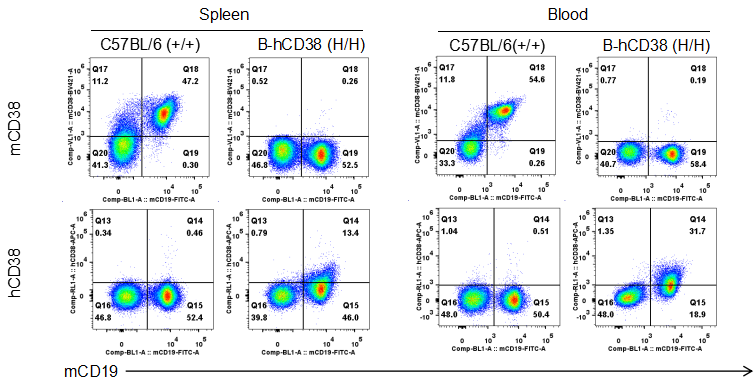
Strain specific CD38 expression analysis in homozygous B-hCD38 mice by flow cytometry. Splenocytes and blood were collected from WT and homozygous B-hCD38 (H/H) mice, and analyzed by flow cytometry with species-specific anti-CD38 antibody. Mouse CD38 was detectable in WT mice. Human CD38 was exclusively detectable in homozygous B-hCD38 but not WT mice.
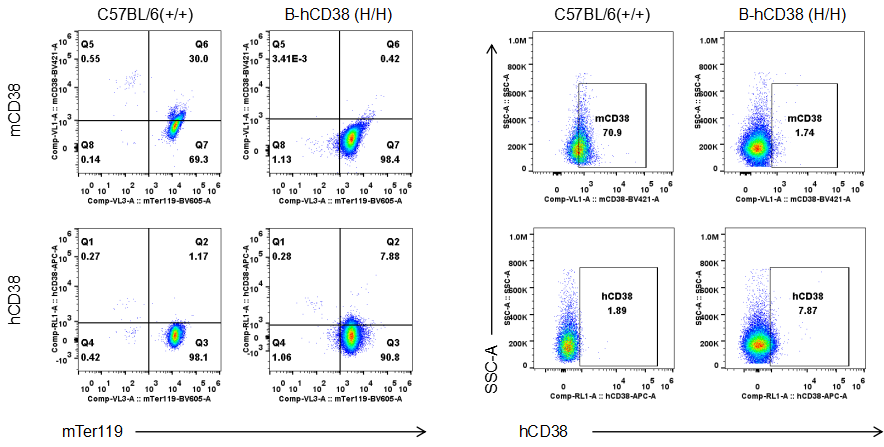
Strain specific CD38 expression analysis in homozygous B-hCD38 mice by flow cytometry. Blood were collected from WT and homozygous B-hCD38 (H/H) mice, and analyzed by flow cytometry with species-specific anti-CD38 antibody. Mouse CD38 was detectable in WT mice. Human CD38 was exclusively detectable in homozygous B-hCD38 but not WT mice.
Analysis of spleen leukocyte subpopulations in B-hCD38 mice
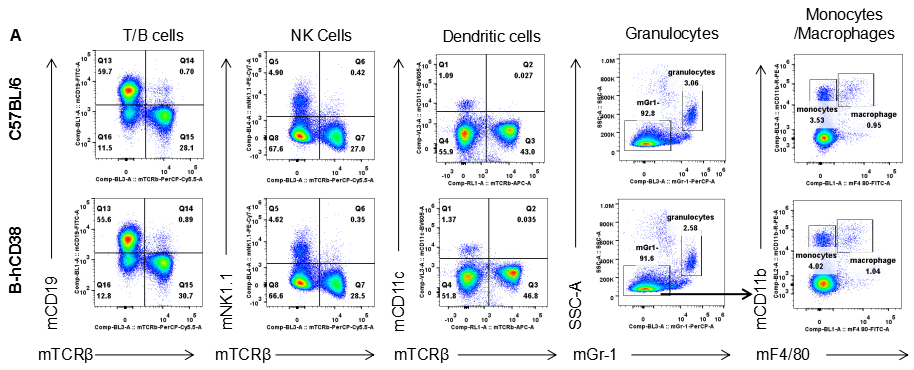
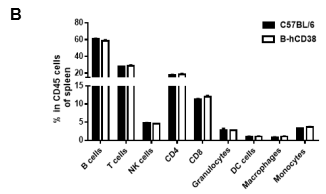
Analysis of splenic leukocyte subpopulations by FACS.Splenocytes were isolated from female C57BL/6 and B-hCD38 mice (n=3, 6 weeks-old) and analyzed by flow cytometry to assess leukocyte subpopulations. (A) Representative FACS plots gated on single live CD45+ cells for further analysis. (B) Results of FACS analysis. Percentages of T, B, NK cells, monocytes/macrophages, and DC were similar in homozygous B-hCD38 mice and C57BL/6 mice, demonstrating that introduction of hCD38 in place of its mouse counterpart does not change the overall development, differentiation, or distribution of these cell types in spleen. Values are expressed as mean ± SEM.
Analysis of spleen leukocyte subpopulations in B-hCD38 mice
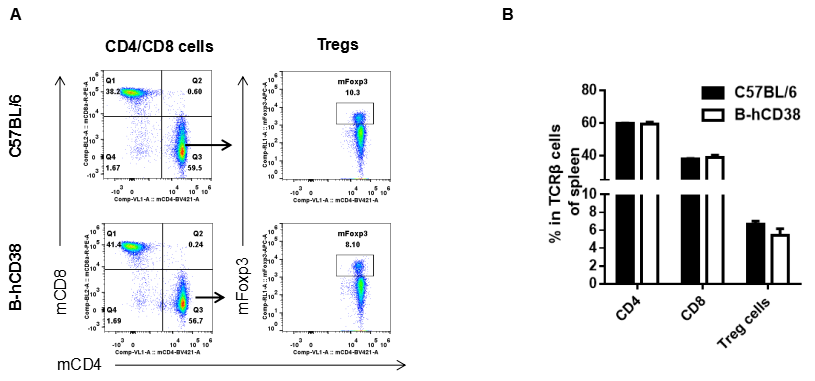
Analysis of splenic T cell subpopulations by FACS. Splenocytes were isolated from female C57BL/6 and B-hCD38 mice (n=3, 6 weeks-old) and analyzed by flow cytometry for T cell subsets. (A) Representative FACS plots gated on TCRβ+ T cells and further analyzed. (B) Results of FACS analysis. Percentages of CD8+, CD4+, and Treg cells were similar in homozygous B-hCD38 and C57BL/6 mice, demonstrating that introduction of hCD38 in place of its mouse counterpart does not change the overall development, differentiation or distribution of these T cell subtypes in spleen. Values are expressed as mean ± SEM.
Analysis of blood leukocyte subpopulations in B-hCD38 mice
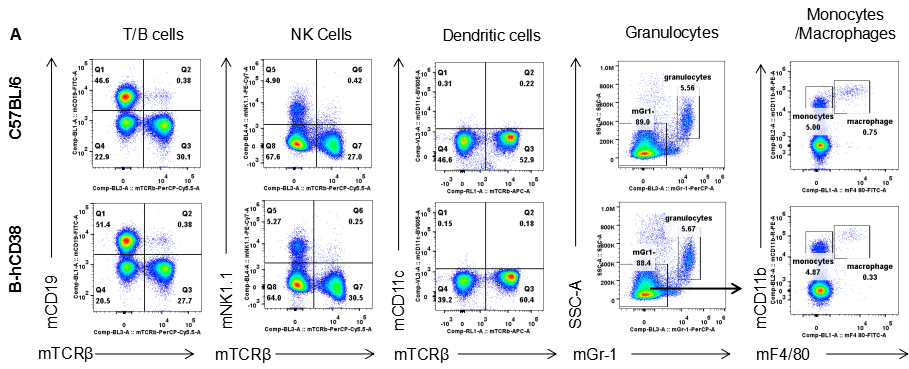
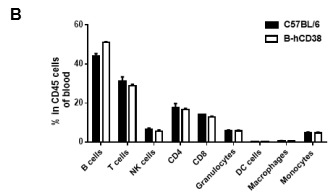
Analysis of blood leukocyte subpopulations by FACS. Blood were isolated from female C57BL/6 and B-hCD38 mice (n=3, 6 weeks-old) and analyzed by flow cytometry to assess leukocyte subpopulations. (A) Representative FACS plots gated on single live CD45+ cells for further analysis. (B) Results of FACS analysis. Percentages of T, B, NK cells, monocytes/macrophages, and DC were similar in homozygous B-hCD38 mice and C57BL/6 mice, demonstrating that introduction of hCD38 in place of its mouse counterpart does not change the overall development, differentiation, or distribution of these cell types in blood. Values are expressed as mean ± SEM.
Analysis of blood leukocyte subpopulations in B-hCD38 mice
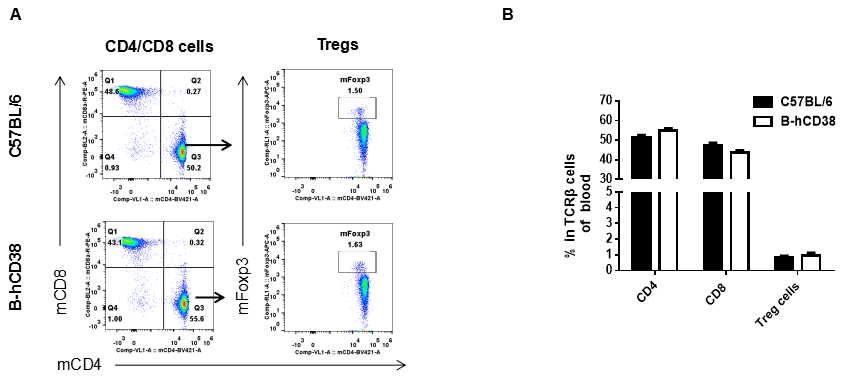
Analysis of blood T cell subpopulations by FACS. Blood were isolated from female C57BL/6 and B-hCD38 mice (n=3, 6 weeks-old) and analyzed by flow cytometry for T cell subsets. (A) Representative FACS plots gated on TCRβ+ T cells and further analyzed. (B) Results of FACS analysis. Percentages of CD8+, CD4+, and Treg cells were similar in homozygous B-hCD38 and C57BL/6 mice, demonstrating that introduction of hCD38 in place of its mouse counterpart does not change the overall development, differentiation or distribution of these T cell subtypes in blood. Values are expressed as mean ± SEM.
Blood routine test results
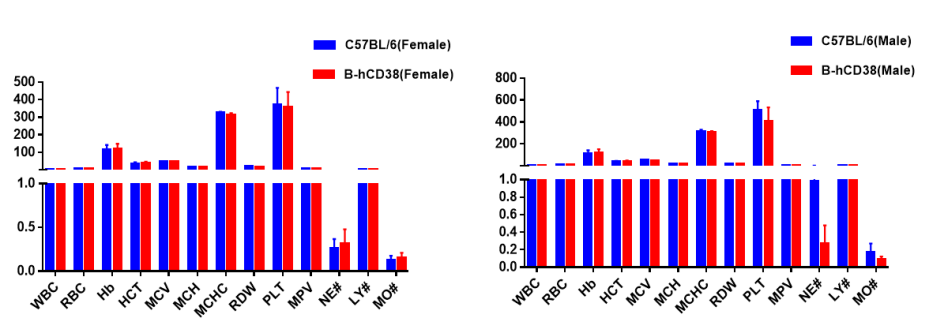
Complete blood count (CBC). Blood from C57BL/6 and B-hCD38 mice (n=5, 6 week-old, female and male) were collected and analyzed for CBC. Any measurement of B-hCD38 mice in the panel were similar to C57BL/6, and there was no differences between male and female mice, indicating that humanized mouse does not change blood cell composition and morphology. Values are expressed as mean ± SEM.
Blood chemistry results
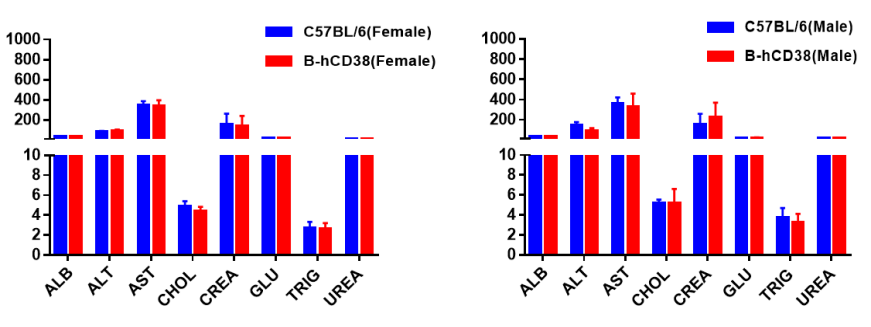
Blood chemistry tests of B-hCD38 mice. Serum from C57BL/6 and B-hCD38 mice (n=5, 6 week-old, female and male) were collected and analyzed for levels of ALT, AST and other indicators in the panel. There was no differences on either measurement between C57BL/6 and humanized mouse, indicating that humanized mouse does not change ALT and AST levels or health of liver. Values are expressed as mean ± SEM.
B-CAG-hCD38 MC38 bind anti-human CD38 antibody
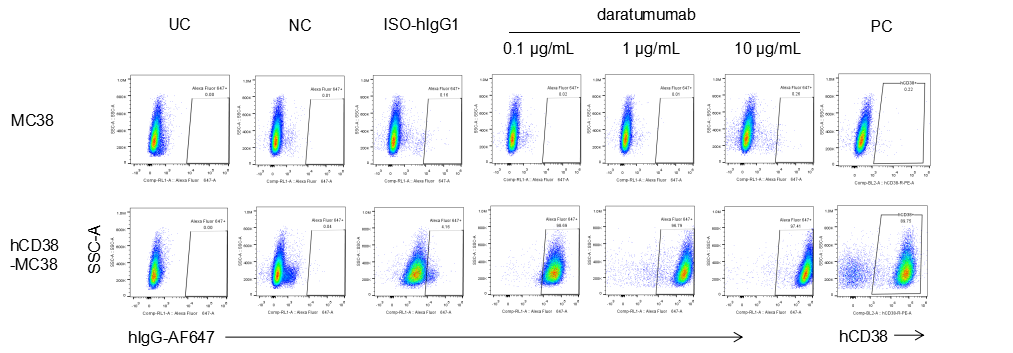
Analysis of B-CAG-hCD38 MC38 by FACS. Flow cytometry analysis of the B-CAG-hCD38 MC38 was performed to assess anti-human CD38 Ab binding. B-CAG-hCD38 MC38 can bind well to anti-hCD38 antibody (daratumumab, in house) vs isotype control.
B cells in B-hCD38 mice bind anti-human CD38 antibody
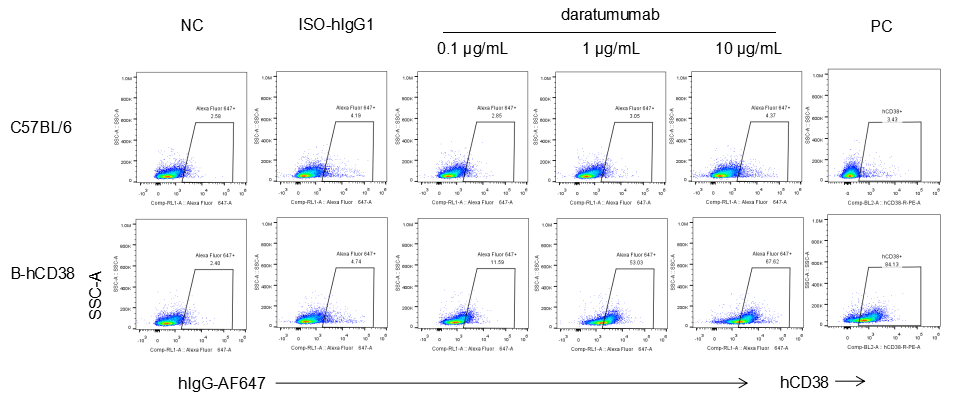
Analysis of splenocytes of B-hCD38 mice by FACS. Splenocytes were isolated from female B-hCD38 mice (6 week-old). Flow cytometry analysis of the splenocytes was performed to assess anti-human CD38 Ab binding with splenocytes. Single live cells were gated for CD19+ population and used for further analysis as indicated here. Splenocytes in homozygous B-hCD38 mice can bind well to anti-hCD38 antibody (daratumumab, in house) vs isotype control.
Combination of anti-human CD38 antibody with the immune cells in B-hCD38 mice
Panel 1: mTER-119, G-anti-hIgG-AF647
Panel 2: Live/Dead, mCD45, mCD3, mCD4, mCD8a, mNK1.1, mFoxp3, G-anti-hIgG-AF647
Panel 3: Live/Dead, mCD45, mCD11b, mCD14, mF4/80, G-anti-hIgG-AF647
Panel 4: Live/Dead, mCD45, mCD3, mCD4, mCD8a, mNK1.1, mFoxp3, hCD38-APC
Panel 5: Live/Dead, mCD45, mCD11b, mCD14, mF4/80, hCD38-APC
In vivo efficacy of anti-human CD38 antibodies

Anti-tumor activity of anti-human CD38 antibody in B-hCD38 mice. (A) Anti-human CD38 antibody (in house) inhibit B-hCD38-luc E.G7-OVA tumor growth in B-hCD38 mice. Murine T lymphocytoma B-hCD38-luc E.G7-OVA cells were injected by tail vein into homozygous B-hCD38 mice (female, 6 week-old, n=6). Mice were grouped when total flux reached approximately 106 Ig, at which time they were treated with anti-human CD38 antibodies indicated in panel. (B) Body weight changes during treatment. As shown in panel A, anti-human CD38 antibodies were efficacious in controlling tumor growth. Values are expressed as mean ± SEM.
In vivo luciferase images of B-hCD38-Luc E.G7-OVA cells
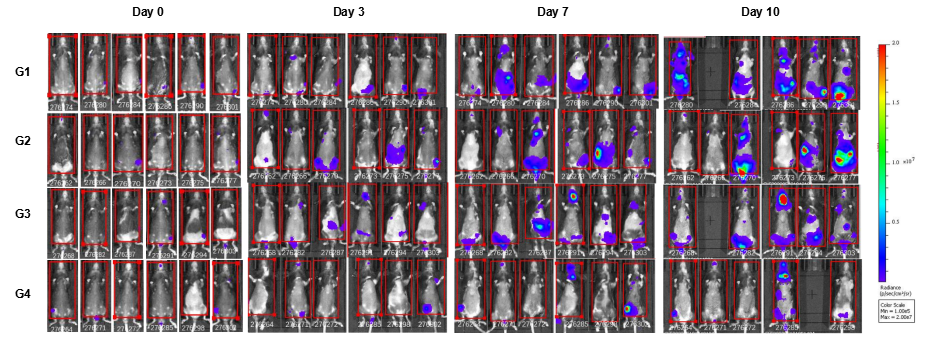
In vivo luciferase images of B-hCD38-Luc E.G7-OVA cells. Mice were grouped when total flux reached approximately 106 Ig, at which time they were treated with anti-human CD38 antibodies. Signal intensity and body weight were measured twice a week. Imaging was performed on days 0, 3, 7 and 10. Values are expressed as mean ± SEM.


























